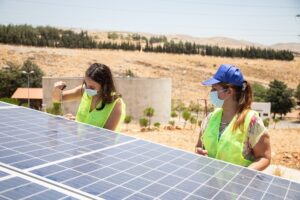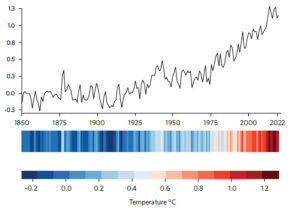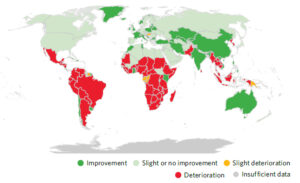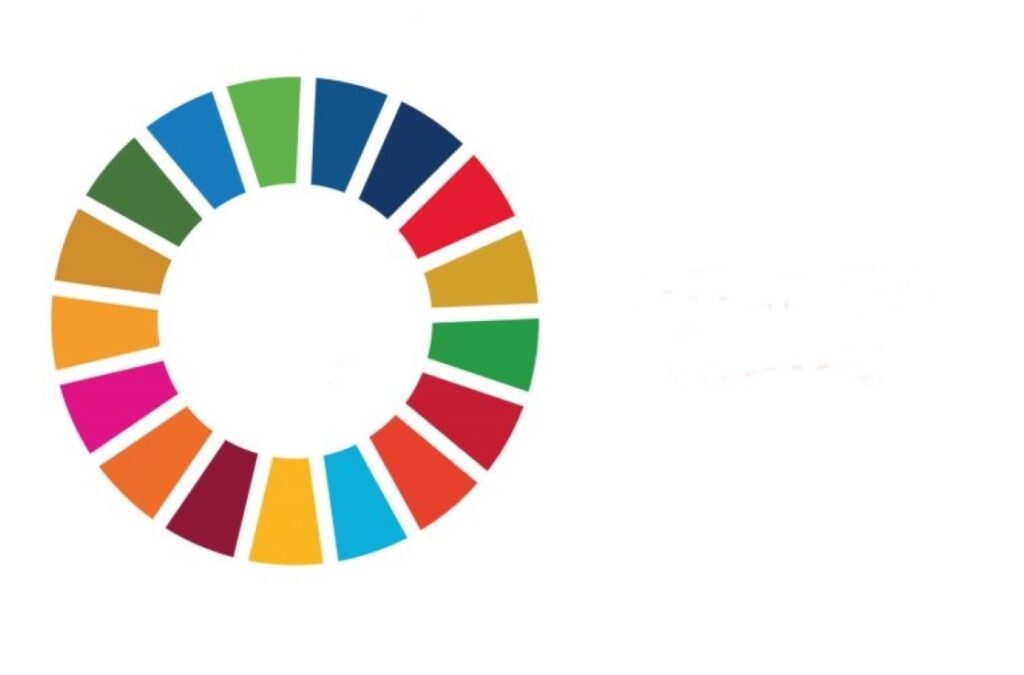"Unless we act now, the Agenda 2030 will become the epitaph of a world that could have been", were the words issued by António GuterresSecretary General of the UNby pointing out that the pledges enshrined in the Sustainable Development Goals are in danger of not being achieved.
The I2023 SDGs report The outlook is very serious, and reaching the mid-term of the Agenda 2030 global urgency to drive progress increases, the UN highlights in an article in the World Economic Forum.
The Agenda 2030 is an action plan composed of 17 Sustainable Development Goals with 169 targets covering the economic, social and environmental spheres, which was approved in September 2015 by the 193 member states of the UN.
The 2023 SDG Report highlights that some progress has been made since 2015, such as in child mortality, access to electricity, and combating certain diseases, but the biggest challenges to meeting are the growing economic gap between developed and developing countries, and the unequal impacts of the climate crisis.
While the number of people living in poverty extreme poverty emissions are growing for the first time in a generation and are on track to reach 575 million by 2030, emissions of greenhouse gases continue to rise, and global temperatures are expected to exceed the critical point of 1.5°C above industrial levels in just over a decade.
The UN says that ending global poverty requires a focus on strategies that reduce inequality and stimulate economic growth, while tackling poverty and inequality. climate change.
Balance of the SDGs
1. End of poverty
The Covid-19 pandemic erased four years of progress in poverty reduction. Rising inflation and the war in Ukraine have led to further setbacks.
It is estimated that as many as 670 million people live in extreme poverty globally, putting the world on track to reduce poverty by just 30% between 2015 and 2030.
2. Zero hunger
Hunger and food insecurity have been on the rise since 2015, further intensified by the compounding effects of the pandemic, geopolitical conflicts, climate change and rising inequalities. The UN estimates that 9.2% of the world's population was chronically hungry in 2022, which is 735 million people or 122 million more than in 2019. Given the current polycrisis, rapid global collaboration is imperative to effectively combat hunger and safeguard food security.
3. Health and wellness
The effects of the pandemic and other crises continue to take their toll on global health, but some progress has been made in recent years. For example, 146 out of 200 countries or areas have already met or are on track to meet the SDG target for under-five mortality rates. But much remains to be done in other areas, such as reducing maternal mortality and expanding universal health coverage.
4. Quality education
The pandemic has caused serious disruption in 80% of the 104 countries surveyed. Without action, 84 million children and youth will remain out of school, and some 300 million students will lack essential literacy and numeracy skills.
5. Gender equality
The world is still far from achieving gender equality by 2030. According to the UN, only 15.4% of Goal 5 indicators are on track to be met. Progress in areas such as unpaid care and domestic work is lagging behind, while nearly half of married women lack the power to make decisions about their sexual and reproductive health. Violence against women remains endemic.
6. Clean water and sanitation
Water demand is increasing due to rapid population growth, growing pressure from agriculture and industry, and threats to wetland ecosystems. Although water use efficiency has improved by 9% since 2015, concerns about water stress and water scarcity are growing.
In 2022, 2.2 billion people still lacked safely managed drinking water, including 703 million without basic water service. More efforts are needed to provide them and to increase cooperation between states across transboundary waters.
7. Affordable and non-polluting energy
Around 660 million people will still be without electricity in 2030 if current trends continue. Slow progress towards clean cooking solutions means that the health of more than 2 billion people is also at risk. As the world moves towards sustainable energy goals, achieving them, as well as climate goals, will require a massive mobilization of public and private capital in renewable energy, especially in developing countries.

8. Decent work and economic growth
The global economy is threatened by multiple crises, with persistent inflation, rising interest rates and increased uncertainty. Real global GDP per capita growth is expected to slow by 2023, leading to a decline in global unemployment, especially among young people. But the pandemic has accelerated digital adoption and improved access to finance.
9. Industry, innovation and infrastructure
Global manufacturing sector growth slowed to 3.3% in 2022 from 7.4% in 2021, amid a slow and uneven recovery from the pandemic. Least developed countries are not on track to double the share of the manufacturing sector in their GDP by 2030. In 2022, 95% of the world's population was within reach of a mobile broadband network, but some areas remain underserved. According to the report, countries with strong infrastructure, including Internet connectivity, are catching up faster.
10. Reduction of inequalities
Income inequality was declining worldwide before Covid-19, but the pandemic may have reversed some of this progress. It has also intensified structural and systemic discrimination, leading to the worst inequality between countries in three decades. The number of refugees in the world reached its highest number ever recorded in 2022, at 34.6 million.
11. Sustainable cities and communities
More than half of the world's population lives in cities, a percentage that could increase to 70% by 2050. More than 1 billion people live in slums or informal settlements, and 2 billion more are expected to be in this situation in the next 30 years. In 2022, only half of the world's urban population had easy access to public transport. Cities continue to face challenges such as urban sprawl, air pollution and a shortage of public open space.
12. Responsible consumption and production
Increasing dependence on natural resources has put the Earth in an unsustainable situation, according to the UN. This is causing the triple crisis of climate change, biodiversity loss and pollution. Some regions of the world generate more environmental impact than others: high-income countries have a material footprint per capita 10 times higher than that of low-income countries. According to the report, governments and citizens must work together to reduce waste and pollution and shape a new circular economy in which we do more with less.
13. Climate Action
The world is on the brink of climate catastrophe and the window to avert it is closing fast. Vulnerable communities are disproportionately affected, despite having contributed the least to the climate crisis, and urgently need global climate finance.
To limit warming to 1.5°C above pre-industrial levels, global greenhouse gas (GHG) emissions must be cut by almost half by 2030.

14. Underwater life
Continued ocean acidification, plastic pollution and rising sea temperatures threaten marine ecosystems. Some progress has been made in expanding marine protected areas, combating illegal fishing and supporting artisanal fishermen, but much remains to be done. According to the report, more than 17 million metric tons of plastic will enter the ocean by 2021, while satellite imagery reveals an increase in coastal eutrophication worldwide by 2022. Rapid and coordinated action is needed to counteract the deteriorating health of the oceans.
15. Life of terrestrial ecosystems
Forest loss, land degradation and species extinction remain major threats to the planet and people, despite positive developments in forest management, environmental policy and accounting. Global forest cover declined from 31.9% in 2000 to 31.2% in 2020, and the risk of extinction of mammal, bird, amphibian and coral species has accelerated by about 11% since 1993. A fundamental change in humanity's relationship with nature is essential, says the UN.

16. Peace, justice and strong institutions
Conflict-related civilian deaths increased by 50% in 2022, largely due to the war in Ukraine. By the end of the year, the record number of forcibly displaced people totaled 108.4 million worldwide, up 19 million from the end of 2021. Homicides worldwide have reached their highest level in 20 years, partly due to the economic impact of the pandemic and socio-political upheaval, according to the UN.
Ending armed conflicts, strengthening institutions and enacting human rights laws are necessary preconditions for sustainable development.
17. Alliances to achieve the objectives
Record inflation, rising interest rates and mounting debt burdens make it harder than ever for many developing countries to prosper economically in the aftermath of the pandemic.
Geopolitical tensions and nationalism are hampering international coordination on important global issues. A collective global effort to provide developing countries with the financing and technologies they need is essential if we are to accelerate implementation of the SDGs, says the UN.
Source: World Economic Forum


